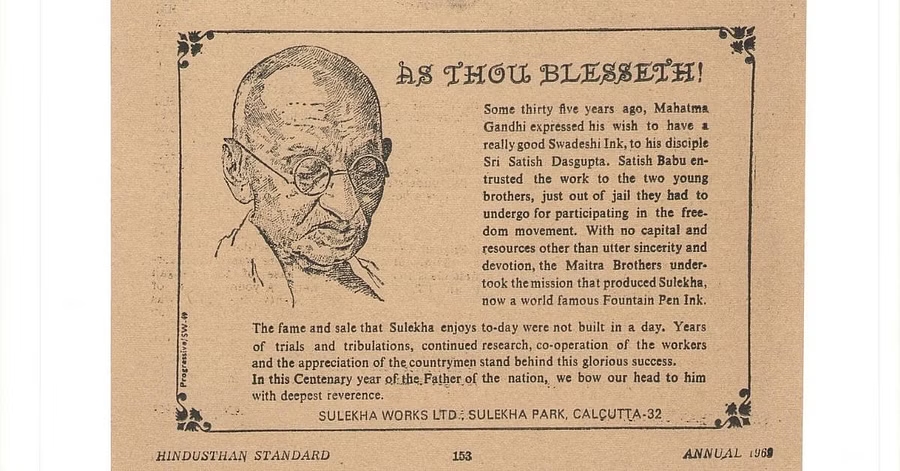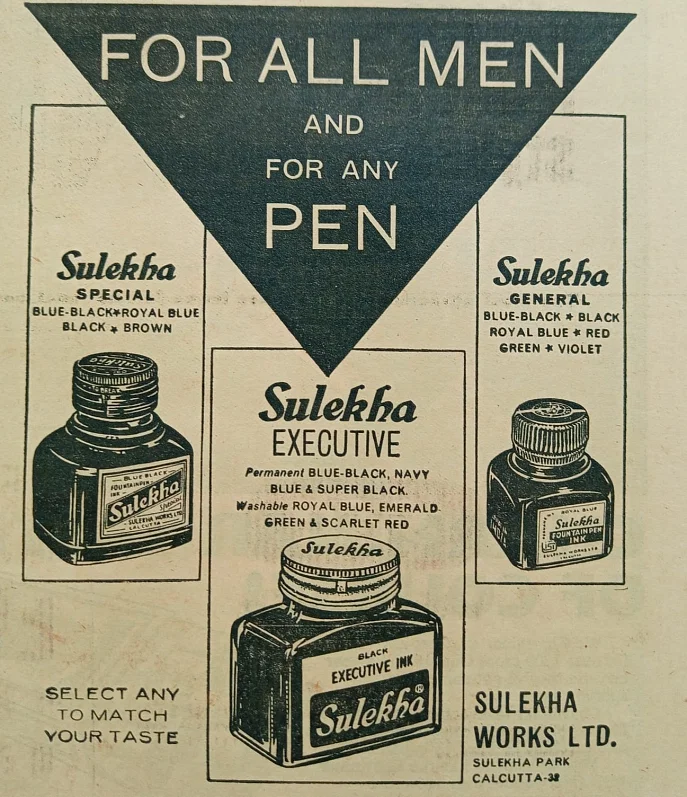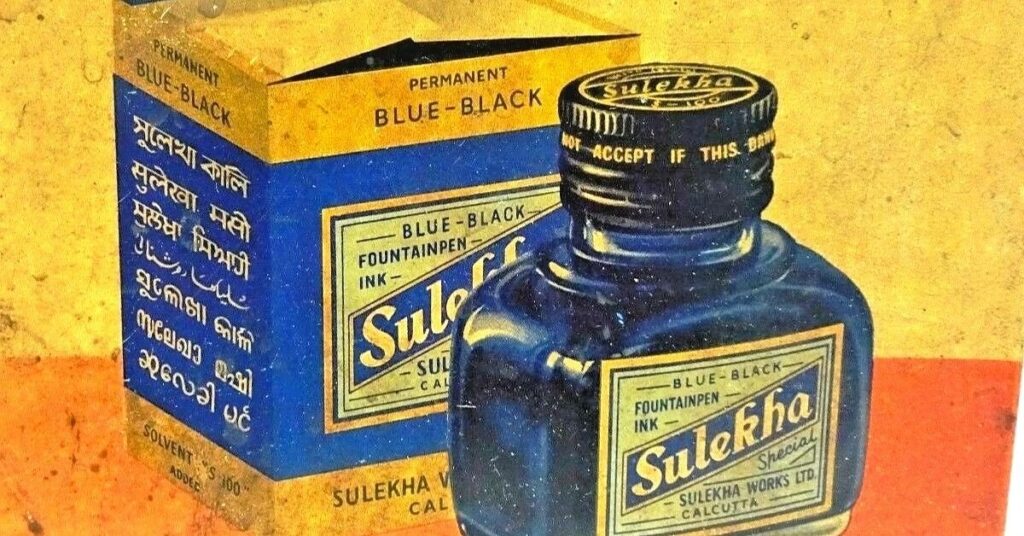Forgotten Brands – Sulekha Ink

A revolutionary past is at the heart of the Sulekha Ink brand. It has come to represent resistance, protest, and even revolution.
During the Swadeshi Movement, people were joining the boycott of foreign products that Mahatma Gandhi had called for.
Local inks had not yet been developed at the time. Gandhi had to use foreign ink while writing letters and other official papers.
Gandhi pondered that it was ironic that the writing about the movement was through imported ink.

He realised India needed its own domestically produced ink. Satish Chandra Dasgupta, a revolutionary liberation movement leader who was also active with Bengal Chemicals, was the man he approached.
In 1932, Satish Das Gupta created an indigenous ink which he dubbed Krishnadhara and began selling via the Khadi retail chain.
He then told two brothers named Nanigopal and Sankaracharya Maitra, both of whom were from Rajshahi (now in Bangladesh), to open a factory. The quality would be superior to the imported ink.
It also took a significant sum of money. Thankfully, the two boys’ mother, Satyabati Maitra, was also an activist. With their mom’s approval and their dad’s life savings, Ambikacharan Maitra and his brother ultimately opened the factory.
Naming
It’s still unclear who came up with this name. Some people attribute the naming to Gandhi, while others credit Rabindranath Tagore.
Sulekha means “to write well.”
Production
Sulekha Ink used the tagline “Swadeshi industry is the backbone of a nation, foreign factories are adverse to independent India” to promote their product. In 1934, in Rajshahi, “Sulekha-Works” began its long and winding journey.
A move to Calcutta by Nani Gopal Maitra. After that, they go to their cousin Asutosh Bhattacharyya’s residence in Barrackpore to carry on with manufacturing and R&D there. Near Sealdah, they also launched a showroom on what was then Harrison Road but is now MG Road.



In the 1930s, Nani Gopal Maitra, who was a physics teacher by day, spent his nights refining the ink’s chemical composition and the women of the Maitra family took up the manufacture of Sulekha. Shankaracharya Maitra, the older brother, managed the company’s marketing and other operations.
A brand-new manufacturing facility was established at Bowbazar in 1938. The plant was relocated twice: first to Kasba in 1939, and again in 1946, to Jadavpur.
In 1946, Sulekha underwent yet another significant change when it was incorporated as a limited liability corporation. Its yearly sales had topped one lakh rupees by the end of 1948.
Two other Sulekha plants, at Sodepur and Ghaziabad, Uttar Pradesh, were established in the 1960s. For a long period, Sulekha’s fame extended beyond its native India.
Ink exports were initiated by Sulekha in 1968. The government of Burma (now Myanmar) placed the first large order for Sulekha via an international tender that attracted participation from American, European, and Chinese conglomerates. There were well-established markets for Sulekha inks, and they were routinely sent to places including the Middle East, the Far East, England, and Australia.
More than 2,000 refugees from East Pakistan (now Bangladesh) found work with Sulekha in the early 1970s. Most of these people made their homes in the Jadavpur, Baghajatin, and Ganguly Bagan neighbourhoods of South Kolkata, close to where the Sulekha plant was located.
The 1980s were a banner decade for Sulekha’s company. At that time, the company’s annual unit sales would often top one million bottles. More than a thousand people had shares in the company. The Sulekha plant will operate on two shifts, the first from 6 am to 2 pm and the second from 2 pm to 10 night.
Because of Sulekha’s unprecedented success, the company began receiving requests from worldwide to open additional plants. In response to a request from Kenya, Sulekha established the continent’s first two ink manufacturers.
Loss of Ground
In the late 1980s, Sulekha’s successful run came to an end when her factory was liquidated along with the other around 65,000 industries in West Bengal under the government of the Left Front.
The business would fall apart in a flash, losing its 89 per cent dominance of the eastern India market in only five years. Furthermore, the firm entered liquidation in 1991.
Patronage
Jawaharlal Nehru, Kazi Nazrul Islam, Subhas Chandra Bose, Rajendra Prasad, Morarji Desai, and Bidhan Chandra Roy were just a few of the famous people that used Sulekha Ink during its illustrious history.
Satyajit Ray adored this ink and made many allusions to it in his films.
On top of all these greats, Rabindranath Tagore once wrote for an advertisement of Sulekha Ink, calling it “blacker than blemish” after being urged to do so by his friend Hemendra Mohan Bose.
The Comeback
From 1989 through 2006, Sulekha was inaccessible. In 2006, though, it made a reappearance, this time producing home care items rather than ink. Production of solar panels was added in 2011.
However, Sulekha’s die-hard fans never stopped clamouring for the restoration of the company’s signature offering. And the miracle occurred in the year 2020 when a global epidemic had the whole planet in its grip. Some supporters created a Facebook group called “Sulekha Ink Lovers” and began pressuring officials during the shutdown.
Since the present investors realised there was still demand for Sulekha Ink, they want to reintroduce it in 2020, complete with the familiar Swadeshi-themed packaging.
Back in Bangladesh
Sulekha opened a facility in its hometown of Rajshahi after being away for 73 years.
Swadeshi, Swaraj, and Swadhin are the current bundle offerings from Sulekha Ink. There are three colour variants in Swadeshi, ten in Swaraj, and two in Swadhin.
Inkpots come in three various colours (executive black, royal blue, and crimson red) and are packaged in custom-made bags in Shantiniketan. Each inkwell may hold up to 60 cc of ink.
Significance
The use of Sulekha Ink has come to represent resistance, protest, and even revolution.



